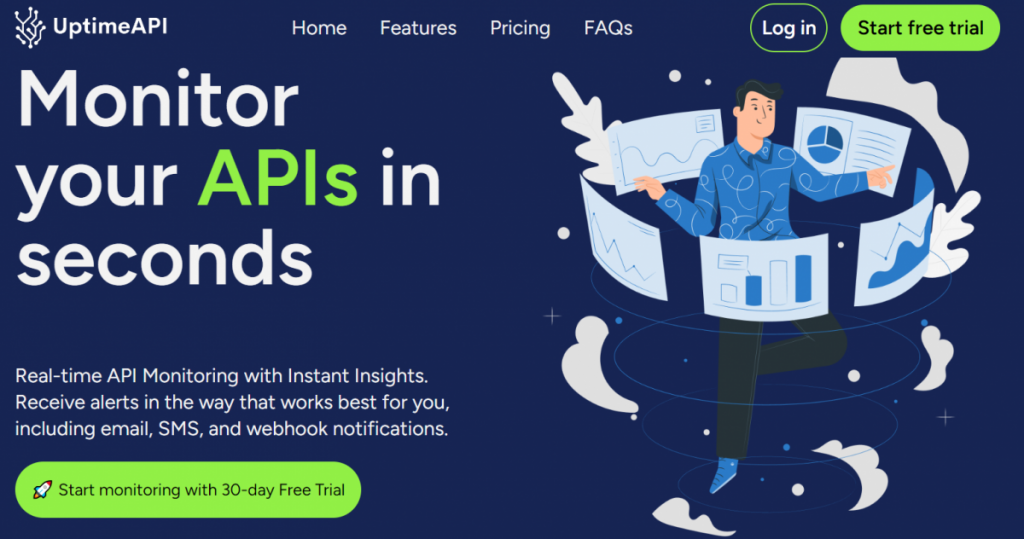In the fast-paced world of digital services, API downtime can be detrimental to businesses, leading to frustrated users and potential revenue loss. To address this challenge, advanced monitoring tools like UptimeAPI come to the forefront, offering comprehensive solutions to detect and mitigate API downtime. In this article, we will delve into the significance of API downtime alerts, explore the key features of UptimeAPI, and provide insights into the API responses that empower users to keep their systems running smoothly.
Understanding the Impact of API Downtime

1. User Experience and Reputation
API downtime directly affects the end-user experience. Whether it’s an e-commerce platform, a mobile application, or a web service, users expect seamless interactions. Downtime disrupts these interactions, leading to frustration and potential abandonment. Moreover, frequent or prolonged downtime can tarnish a business’s reputation, eroding trust among users.
2. Revenue Loss and Opportunity Cost
For businesses relying on APIs for transactions or services, downtime translates into revenue loss. Every minute of unavailability can result in financial setbacks. Additionally, the opportunity cost of potential new customers or business opportunities during downtime can have long-lasting effects on a company’s bottom line.
UptimeAPI: A Beacon of Reliability

Read More: Company profile APIUsage Cases
1. Real-Time Monitoring
UptimeAPI offers real-time monitoring capabilities, ensuring that any instance of API downtime is detected promptly. Real-time monitoring is essential for minimizing the impact on users and maintaining a high level of service availability.
2. Customizable Alerting System
One of the standout features of UptimeAPI is its customizable alerting system. Users can set up alerts based on specific criteria, such as response time thresholds, HTTP status codes, or error rates. This flexibility allows businesses to tailor alerts to their unique operational needs.
3. Multi-Channel Notifications
UptimeAPI understands the importance of immediate awareness during downtime. The tool supports multi-channel notifications, sending alerts through channels like email, SMS, and integrations with popular communication platforms. This ensures that the right people are informed promptly, facilitating swift response and resolution.
API Downtime Alerts: How UptimeAPI Responds
Understanding the API responses provided by UptimeAPI is crucial for effective incident management during downtime. Let’s break down what users can expect:
1. Alert Triggering
When an API downtime event occurs, UptimeAPI triggers an alert based on the predefined criteria set by the user. This could include reaching a specified response time threshold, encountering a particular HTTP status code, or a complete unavailability of the API.
2. Instant Notifications
Once an alert is triggered, UptimeAPI sends instant notifications to the designated contacts or teams. These notifications can be configured to reach users through multiple channels simultaneously, ensuring that no critical information is missed.
3. Detailed Incident Reports
UptimeAPI goes beyond simple alerts by providing detailed incident reports. These reports include comprehensive information about the downtime event, such as timestamps, error details, and historical performance metrics. This level of detail aids in quick diagnosis and resolution of the underlying issues.
4. Integration with Incident Management Tools
To streamline the incident response process, UptimeAPI integrates seamlessly with popular incident management tools. This allows users to centralize their incident response efforts, track the status of ongoing incidents, and maintain a comprehensive record of downtime events for post-incident analysis.
Getting Started with UptimeAPI Downtime Alerts
1. Create an Account
Begin by signing up for an account on the UptimeAPI platform. The onboarding process is user-friendly, guiding you through the necessary steps to set up your monitoring environment.
2. Configure API Endpoints
Add the API endpoints you want to monitor. UptimeAPI supports various protocols, ensuring compatibility with a wide range of applications. Specify the parameters for alert triggering, such as response time thresholds or specific HTTP status codes.
3. Customize Alert Settings
Tailor the alert settings according to your operational requirements. Define who should receive notifications, how alerts should be escalated, and which channels should be used for communication.
4. Integration with Communication Channels
Take advantage of UptimeAPI’s multi-channel notification support. Integrate with your preferred communication channels, such as email, SMS, or collaboration platforms like Slack, to ensure that alerts reach the right people in a timely manner.
5. Review Incident Reports and Analysis
In the event of API downtime, utilize UptimeAPI’s detailed incident reports to perform a thorough analysis. Identify root causes, assess the impact on users, and implement preventive measures to minimize future occurrences.
Conclusion: Elevate Your API Monitoring with UptimeAPI Downtime Alerts
In the dynamic digital landscape, where API downtime can have far-reaching consequences, having a robust monitoring solution is imperative. UptimeAPI, with its real-time monitoring, customizable alerting system, and detailed incident reports, empowers businesses to not only detect downtime promptly but also respond efficiently. By understanding the intricacies of UptimeAPI’s API responses and following the steps to set up downtime alerts, users can fortify their systems against disruptions, ensuring a consistently reliable experience for their users. Embrace UptimeAPI today and make API downtime a thing of the past.

